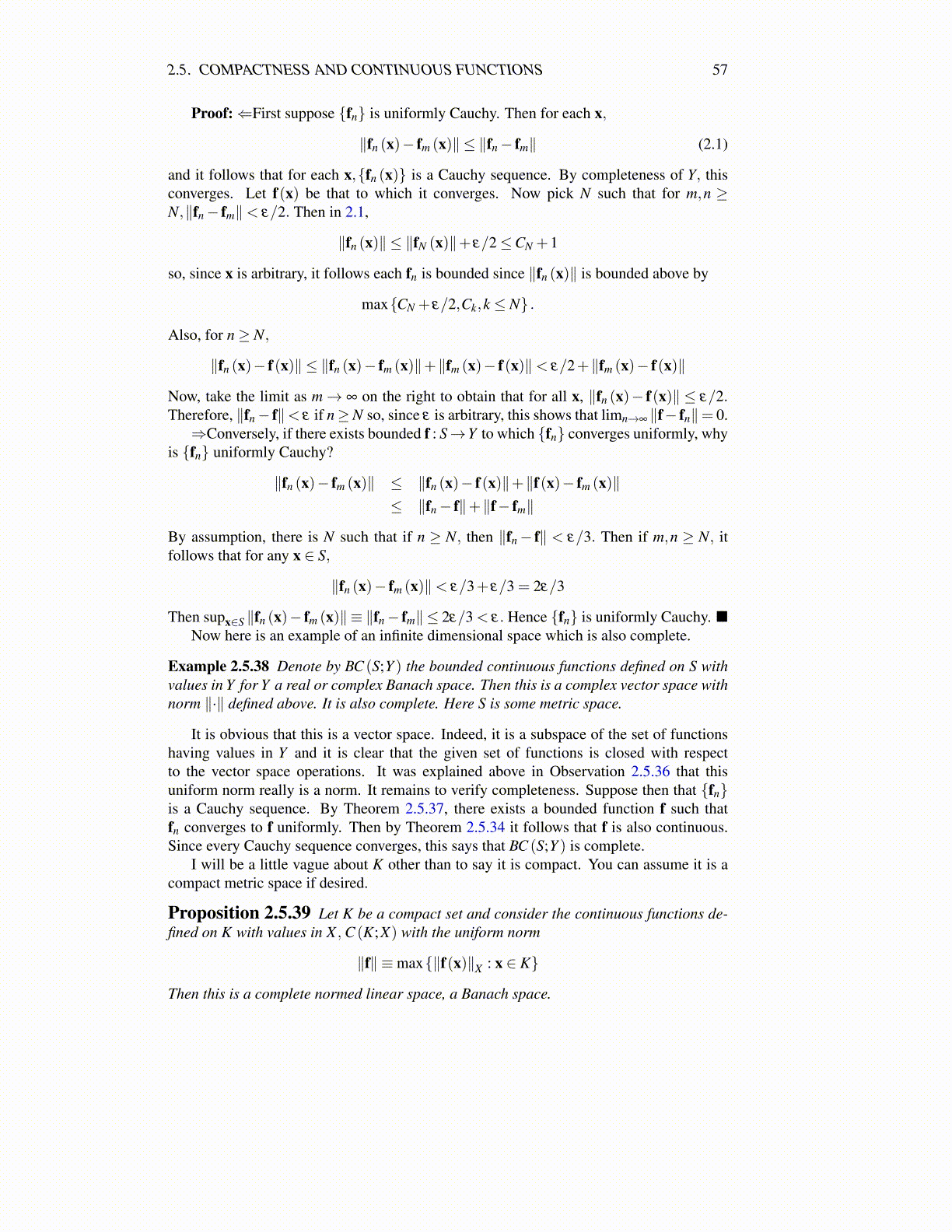
2.5. COMPACTNESS AND CONTINUOUS FUNCTIONS 57
Proof:⇐First suppose {fn} is uniformly Cauchy. Then for each x,
∥fn (x)− fm (x)∥ ≤ ∥fn− fm∥ (2.1)
and it follows that for each x,{fn (x)} is a Cauchy sequence. By completeness of Y, thisconverges. Let f(x) be that to which it converges. Now pick N such that for m,n ≥N,∥fn− fm∥< ε/2. Then in 2.1,
∥fn (x)∥ ≤ ∥fN (x)∥+ ε/2≤CN +1
so, since x is arbitrary, it follows each fn is bounded since ∥fn (x)∥ is bounded above by
max{CN + ε/2,Ck,k ≤ N} .
Also, for n≥ N,
∥fn (x)− f(x)∥ ≤ ∥fn (x)− fm (x)∥+∥fm (x)− f(x)∥< ε/2+∥fm (x)− f(x)∥
Now, take the limit as m→ ∞ on the right to obtain that for all x, ∥fn (x)− f(x)∥ ≤ ε/2.Therefore, ∥fn− f∥< ε if n≥N so, since ε is arbitrary, this shows that limn→∞ ∥f− fn∥= 0.⇒Conversely, if there exists bounded f : S→Y to which {fn} converges uniformly, why
is {fn} uniformly Cauchy?
∥fn (x)− fm (x)∥ ≤ ∥fn (x)− f(x)∥+∥f(x)− fm (x)∥≤ ∥fn− f∥+∥f− fm∥
By assumption, there is N such that if n ≥ N, then ∥fn− f∥ < ε/3. Then if m,n ≥ N, itfollows that for any x ∈ S,
∥fn (x)− fm (x)∥< ε/3+ ε/3 = 2ε/3
Then supx∈S ∥fn (x)− fm (x)∥ ≡ ∥fn− fm∥ ≤ 2ε/3 < ε. Hence {fn} is uniformly Cauchy. ■Now here is an example of an infinite dimensional space which is also complete.
Example 2.5.38 Denote by BC (S;Y ) the bounded continuous functions defined on S withvalues in Y for Y a real or complex Banach space. Then this is a complex vector space withnorm ∥·∥ defined above. It is also complete. Here S is some metric space.
It is obvious that this is a vector space. Indeed, it is a subspace of the set of functionshaving values in Y and it is clear that the given set of functions is closed with respectto the vector space operations. It was explained above in Observation 2.5.36 that thisuniform norm really is a norm. It remains to verify completeness. Suppose then that {fn}is a Cauchy sequence. By Theorem 2.5.37, there exists a bounded function f such thatfn converges to f uniformly. Then by Theorem 2.5.34 it follows that f is also continuous.Since every Cauchy sequence converges, this says that BC (S;Y ) is complete.
I will be a little vague about K other than to say it is compact. You can assume it is acompact metric space if desired.
Proposition 2.5.39 Let K be a compact set and consider the continuous functions de-fined on K with values in X , C (K;X) with the uniform norm
∥f∥ ≡max{∥f(x)∥X : x ∈ K}
Then this is a complete normed linear space, a Banach space.